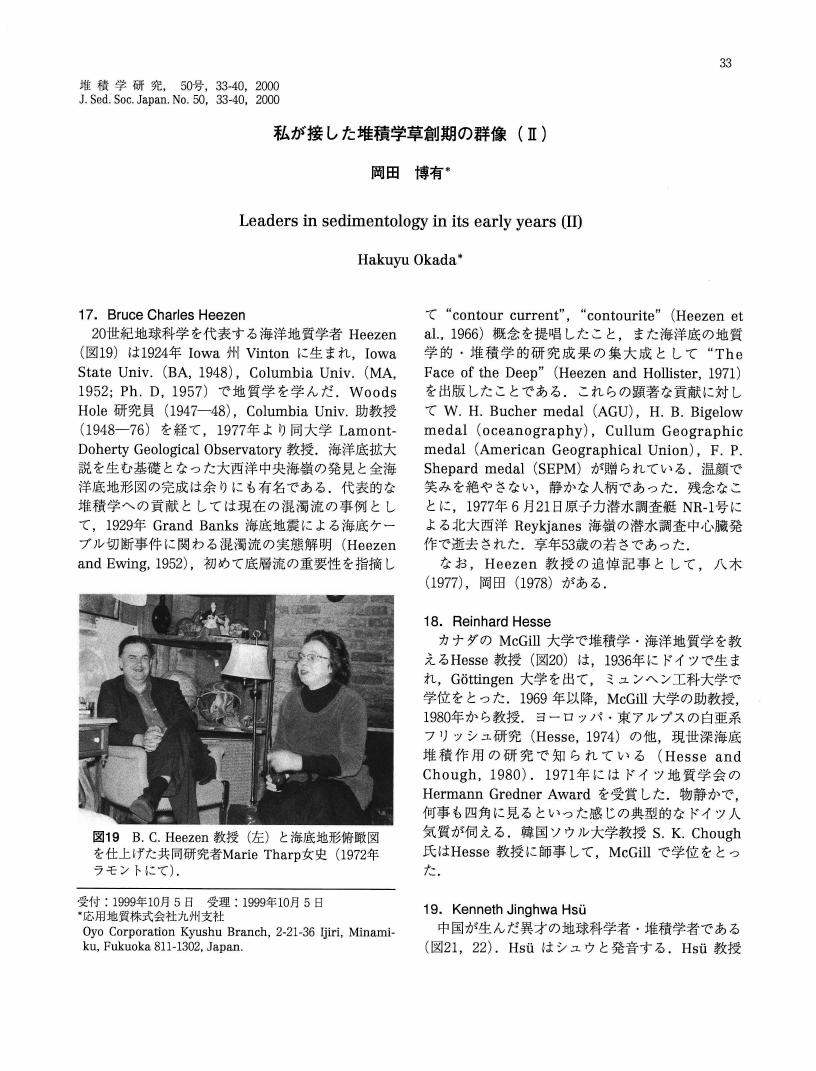9 0 0 0 IR 日本最初の用語「地質学」の成立: 箕作阮甫(1799-1863)の貢献
- 著者
- 岡田 博有 鈴木 茂之
- 出版者
- 岡山大学理学部地球科学教室
- 雑誌
- Okayama University Earth Science Report (ISSN:13407414)
- 巻号頁・発行日
- vol.16, no.1, pp.1-7, 2009-12-25
The first Japanese word "chishitsu-gaku" for the "geology" was proposed by Genpo Mitsukuri, a scientific contributor in the Tokugawa regime in the 19th century, who was born in 1799 in Tsuyama in Western Honshu, Japan and had worked for scientific activities of the Tokugawa government from 1839 to 1863. His major works for the first making of the "chishitsu-gaku" for the "geology" have been presented in this paper, also showing his contribution to Japanese sciences.
4 0 0 0 OA 私が接した堆積学草創期の群像 (II)
- 著者
- 岡田 博有
- 出版者
- The Sedimentological Society of Japan
- 雑誌
- 堆積学研究 (ISSN:1342310X)
- 巻号頁・発行日
- vol.50, no.50, pp.33-40, 2000-02-15 (Released:2010-05-27)
- 参考文献数
- 35
1 0 0 0 OA 壱岐, 中新統勝本層に見られる背弧海盆堆積物の堆積相と堆積環境
- 著者
- 鬼頭 剛 坂井 卓 岡田 博有
- 出版者
- The Sedimentological Society of Japan
- 雑誌
- 堆積学研究会報 (ISSN:18844715)
- 巻号頁・発行日
- vol.38, no.38, pp.57-66, 1993-03-30 (Released:2010-05-27)
- 参考文献数
- 27
The Middle Miocene Katsumoto Formation, distributed in the northern and central part of Iki Island, Nagasaki Prefecture, has been considered as a typical back-arc basin sequence. This study aims to describe sedimentary facies, ichinofacies and paleocurrent system and to discuss sedimentary environments and depositional systems. The Katsumoto Formation, attaining more than 450m in thickness, shows a coarsening- and thickening-upward sequence as a whole. It begins with mud-dominated facies of interbedded sandstone and mudstone, passes upward into medium-bedded, medium-grained sandstone and siltstone facies, and ends with thick-bedded, medium- to coarse-grained sandstone facies at top. Six sedimentary facies recognized. Their lithologies are summarized as follows; Facies A: mainly well-sorted, medium to very coarse sandstone with planer to tabular cross-stratification, Facies B: well-sorted, very fine to medium sandstone with amalgamated hummocky cross-stratification (HCS), Facies Ca: interbedded HCS sandstone and siltstone, Facies Cb: thinly interbedded HCS sandstone and siltstone, Facies D: mottled sandy siltstone with thin very fine-grained sandstone, Facies Fa: slump breccia, Facies Fb: slump folded thinly interbedded sandstone and mudstone, and Facies F: interbedded very fine-grained turbidite sandstone and mudstone. The sedimentary environments inferred from Facies A to F are summarized as follows; Facies A: upper shoreface, Facies B: lower shoreface, Facies Ca and Cb: inner shelf, Facies D: outer shelf, Facies Ea: shelf margin, Facies Eb: continental slope, and Facies F: basin plain. Fossil evidence, such as burrowing organisms and benthonic foraminiferas obtained from the formation, seems to coincide with these environments. Eastward and northeastward paleoflows are dominant in the lower, and the middle and upper parts of the formation, respectively. It can be concluded, therefore, that the Katsumoto Formation represents a facies succession from basin plain to tide-dominated shallow marine sediments due to northeastward progradation process. The northeastward progradation system is also recognized in the regional area of the Tsushima Basin in the Middle Miocene time.
- 著者
- 岡田 博有 徳山 英一 CHAMLEY H. CHARVET J. FAURE M. LALLEMANT S. LEGGETT J RANGIN C. RENARD V. 飯山 敏道 PICHON LE X. 藤本 勝己 古田 俊夫 井田 喜明 加賀美 英雄 村田 明広 平 朝彦
- 出版者
- 一般社団法人 日本地質学会
- 雑誌
- 日本地質学会学術大会講演要旨 (ISSN:13483935)
- 巻号頁・発行日
- vol.1985, 1985
1 0 0 0 インド, ゴンドワナ地方の白亜紀オラーコジン堆積物
1 0 0 0 白亜紀の陸と海の生物の多様性の解析と国際対比
九州の中軸帯および黒瀬川構造帯には白亜紀堆積盆が広く発達する。その層序学的・堆積学的ならびに構造地質学的諸特徴には東アジアの活動的縁辺域で生じた白亜紀のテクトニクス変化が記録されている。黒瀬川構造帯の下部白亜紀系は断層規制を受けた堆積盆に形成され, 非海成〜浅海相ならびにタービダイト相からなる二つの異なるタイプのシークェンスが識別できる。これらは, 多くの不整合を伴って顕著な岩相変化を示す。このような堆積盆は, 分断された黒瀬川古陸上に形成された横ずれ構造盆にあたり, 白亜紀前期にカリフォルニア型のトランスフォーム縁辺が推定される。このことは黒瀬川構造帯の堆積盆が北北西-南南東の左横ずれ断層を伴うタンル-断層システムに属していたことを示唆する。一方, 中軸帯の後期白亜紀堆積盆は非海成〜浅海性相(御所浦・御船層群)と浅海〜タービダイト相(大野川・姫浦層群)の二つの異なるシークェンスからなる。前者は先白亜紀の構造に対し, オーバーラップの層序関係を示し, ベンチ状あるいは陸棚性前弧海盆に比較できる。後者は軸流運搬のタービダイト相が卓越し, 伸長性堆積盆を示す。堆積作用と変形スタイルの特徴から, 大野川, 姫浦層群はそれぞれ横ずれ構造盆, 断層規制を受けた陸棚盆に相当する。黒瀬川構造帯堆積盆の北方への顕著な堆積盆の移動は, 縫合性島弧地塊と前期白亜紀に隣接していたイザナギ・プレートの間のトランスフォーム過程に関連したと推定される。引き続く中軸帯の堆積盆のタイプの時空的変化は, 後期白亜紀のクラ, 太平洋プレートの収れん運動の変化に対応するだろう。
1 0 0 0 OA 北海道空知背斜のトリゴニア砂岩
- 著者
- 岡田 博有
- 出版者
- 日本地質学会
- 雑誌
- 地質學雜誌 (ISSN:00167630)
- 巻号頁・発行日
- vol.67, no.790, 1961-07-25


